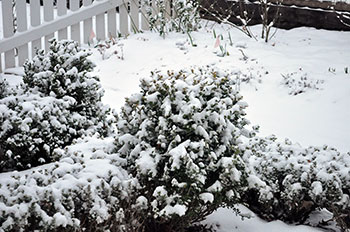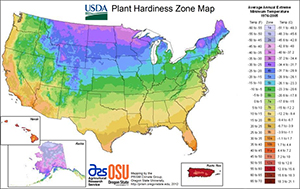The Affect of Cold Temperatures on Plants
Return to Environment articles.
 When the temperature swings from mild days to bitter cold nights, we personally are shocked by the sharp change in weather even though we know it is winter. Near zero or colder temperatures is normal for the Kansas City area. Heavy snowfall is also common. People have been asking about the affect of the cold temperatures on landscape plants.
When the temperature swings from mild days to bitter cold nights, we personally are shocked by the sharp change in weather even though we know it is winter. Near zero or colder temperatures is normal for the Kansas City area. Heavy snowfall is also common. People have been asking about the affect of the cold temperatures on landscape plants.
The good news is that most landscape plants will tolerate the cold spells. There is a greater concern when we experience rapid temperature changes in the late fall or spring. More damage can result when the plants are not properly prepared for winter or have begun spring growth.
For example, a sudden cold snap can result in a poor leaf drop from the trees due to the rapid change. Other concerns are dieback as some plant materials were not properly hardened for winter. Broadleaf evergreens or plants that put on a late summer flush of growth are most at risk.
 Temperature affects plants, not wind chills. Wind chill is a human measure and means nothing to plant material. Plants are rated as to their absolute winter temperature tolerances based on plant hardiness zones. The USDA Plant Hardiness Zone Map classifies trees, shrubs, and flowers by the lowest temperature they will survive. Hardiness zones range from 13 to 1. Zone 13 is the warm and tropical islands of Puerto Rico and Hawaii while zone 1 is the tundra of Alaska.
Temperature affects plants, not wind chills. Wind chill is a human measure and means nothing to plant material. Plants are rated as to their absolute winter temperature tolerances based on plant hardiness zones. The USDA Plant Hardiness Zone Map classifies trees, shrubs, and flowers by the lowest temperature they will survive. Hardiness zones range from 13 to 1. Zone 13 is the warm and tropical islands of Puerto Rico and Hawaii while zone 1 is the tundra of Alaska.
Kansas City is located in zone 6b. Plant materials hardy in our zone will survive minimum winter lows of 0°F to -5°F.
Plants with roots that are well covered or properly mulched should be acclimated to winter temperatures and have no problem. We often try to push the limits on plant materials. Two common plants grown here are crape myrtle and mimosa. Expect winter injury when the temperatures drop below zero.
One condition that can affect winter hardiness is the moisture level in the soil. Dry soil conditions will decrease winter hardiness and increase desiccation. A good example of this is evergreens and broadleaf evergreens such as boxwood and holly. Continual loss of water during the winter can be serious if dry conditions prevail. Damage results in a browning or killing of the foliage.
If you’ve landscaped using plants for our designated hardiness zone then they should be accustomed by now to the cold and snow. This will help them survive Mother Nature’s fickle fluctuations this season and set them up for spring. But then, there are no guarantees. We’ll just have to cross our fingers and wait and see.
By Dennis L. Patton, M.S., County Horticulture Agent, K-State Research and Extension/Johnson County
Have questions?
The Garden Hotline is staffed by trained EMG volunteers and Extension staff who will assist you with questions. Phone: (913) 715-7050. Email: garden.help@jocogov.org